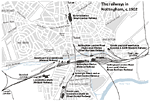
Overview
The earliest reference to a railway in the county is contained in a lease dated 1604 between Sir Percival Willoughby of Wollaton Hall and the mining entrepreneur, Huntingdon Beaumont, which confirms the right of Beaumont to carry coals “alonge the passage now laide with railes, and with suche or the lyke Carriages as are now in use for the purpose.” The wagonway ran for two miles between coal pits in Strelley and a distribution point in Wollaton. The wagons or carriages were drawn by horses on wooden rails.
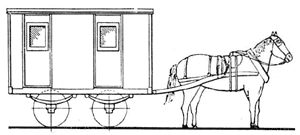
Horse-drawn passenger carriage built by the Midland Railway in Derby for the Mansfield & Pinxton line (1848).
A number of railways were built during the late 18th and early 19th centuries in the west of Nottinghamshire to transport coal from the collieries to the canal network. The most notable was the Mansfield and Pinxton Railway, which was built under a parliamentary act of 1817 to link the town with the Cromford Canal at Pinxton which provided access to wider markets for local coal and Mansfield’s building stone and lime. It opened in 1819 and the wagons were horse-drawn; passenger services, also horse-drawn, started in 1832.
The opening of the Leicester and Swannington Railway in 1832 alarmed the colliery owners of the Erewash valley because it threatened to undermine their business supplying coal to Leicester. A meeting was arranged at the Sun Inn in Eastwood on 16 August of that year and there it was agreed that a railway should be built to allow their coal to compete on the Leicester market. The meeting led to the creation of the Midland Counties Railway (MCR), the forerunner of the Midland Railway (MR).
The MCR’s bill to connect Nottingham and Derby and Trent (near Long Eaton) to Leicester and Rugby was authorised by Parliament in 1836. The company urgently needed income so concentrated on constructing the Derby-Nottingham section first and Nottingham’s first station was opened with great ceremony on 30 May 1839 on the west side of Carrington Street. The station was built as a terminus of the branch line from Derby, much to the indignation of the town corporation. Access to the station from the town was difficult until Carrington Street was extended over the nearby canal and Queen’s Road created for the visit of Queen Victoria and the Prince Consort in December 1843.
Railway Mania (1845-6)
The mid-1840s saw the speculative frenzy known as ‘Railway Mania’ grip the country. It reached its peak in 1846 with 272 Acts of Parliament passed authorising the creation of many new railway companies. A large number of these lines were never built and the bubble burst leading to ruin for many investors.
The mania of 1845 was neatly summed-up by The Nottingham Date Book:
“The year is further memorable for an extraordinary movement known as ‘the railway mania.' For several months the money market was deluged with a flood of prospectuses of railway schemes of every character; a Stock Exchange was established in the town; the most fabulous gains were reported; and amongst the holders of stock were clerks, small shopkeepers, and many of no capital whatever. When "the panic" came, nearly the whole of these projects dissolved into airy nothingness, and the holders of the scrip found themselves involved in ruinous expenses.”
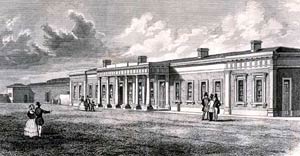
The second Midland Railway station at Nottingham was built in 1848.
The Midland Railway next embarked on the construction of a line from Nottingham to Lincoln along the Trent valley that took eight months to build and opened in August 1846. The opening of the line revealed the inadequacies of the existing station on Carrington Street so the MR built a new one on Station Street, which opened in May 1848. Newark on Trent was the main town on the route to Lincoln and a handsome small station was erected near the castle.
Although the line between Nottingham and Newark bypassed the cathedral town of Southwell a single-track branch from Rolleston Junction to the town was opened in 1847. An extension from Southwell to Mansfield was constructed in 1871; this became important in opening-up the coalfield to the east of Mansfield in subsequent years.
The MR was also busy building new lines to tap important coal reserves in its territory:
- A branch line up the Erewash Valley from Long Eaton past Ilkeston and Langley Mill to Codnor Park opened in 1847
- A line along the Leen Valley from Nottingham via Bulwell, Hucknall and Annesley was constructed in 1848 and extended to Mansfield in 1849
- The Mansfield & Pinxton Railway was acquired by the MR in 1847 and then re-engineered by having its curves ironed out and gradients levelled to become part of an extension from Codnor Park to Mansfield completed in 1849
In the same period, the Manchester, Sheffield & Lincolnshire Railway arrived in Nottinghamshire when they extended their line from Woodhouse Junction near Sheffield to Gainsborough in 1848-9. The new route across the north of the county included stations at Worksop and Retford.
The Great Northern Railway vs. the Midland Railway (1850-1890)
The ambitious Ambergate, Nottingham & Boston & Eastern Junction Railway (ANB&EJR) scheme of 1845 was designed to link the north-west with ports on the east coast and the stretch between Nottingham and Grantham was opened in 1850. The line from Grantham only ran as far as the junction with the MR at Colwick on the east of the town; running powers were obtained over the MR line to their station in Nottingham. However, this marked the beginning of a struggle between MR and GNR for control of the Ambergate.
In August 1852 the GNR opened the ‘Towns Line’ between Peterborough and Retford which completed their London to York route. A short while afterwards, the company started to advertise through services from London to Nottingham, using their running powers over the ANB&EJR. The inaugural train of this new service arrived at Nottingham station in August 1852 and was drawn by a GNR locomotive. MR staff reacted angrily and kidnapped the locomotive, took it to one of their engine sheds and removed the access rails. The locomotive remained there for the next seven months!
The MR then refused to accept through traffic and the Ambergate Railway was forced to transport goods to Colwick by cart. Acts of Parliament of 1853 and 1854 allowed the Ambergate to abandon the construction of lines east of Grantham, to amalgamate with the GNR and to build a line from Colwick to Nottingham with a station at Eastcroft. The new station was built on London Road and opened, along with an impressive goods and corn warehouse, on 3 October 1857. The buildings were designed by the noted Nottingham architect, T. C. Hine. The station eventually provided the GNR “with a base from which to invade the nearby coalfield.”
The London coal market was beginning to become important and lucrative to the railway companies and the development of the coal industry in west Nottinghamshire became another source of conflict between the GNR and MR and the1870s saw the GNR attempting to break the MR’s monopoly of the coal traffic between the coalfield and London.
The Derbyshire and Staffordshire Extension between Colwick and Egginton Junction (in Staffordshire) was built during 1872-8 with a branch up the Erewash Valley from Awsworth to Pinxton via Eastwood. This line was deliberately designed to run near all the main collieries in the Erewash Valley and included the impressive 1,440 foot long Bennerley viaduct (1878) and the Giltbrook viaduct (’40 bridges’). Another GNR line running up the Leen Valley from Bulwell to Newstead (alongside the MR’s Mansfield Branch line) opened in 1882 and was extended to Shirebrook in 1901. The Leen Valley Line’s main objective was “to muscle in on the coal trade” and soon every major colliery in the area had both GNR and MR branches running into it.
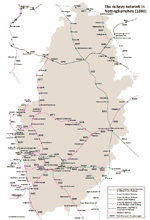
Map of the railway network in Nottinghamshire in 1880 (click on the image to view a larger version of the map).
The GNR also opened a line connecting Newark and Bottesford West Junction in 1878 and a joint line with the London and North Western Railway (LNWR) through Leicestershire in 1879. This rapid expansion in GNR activities around Nottingham led to the development of the Colwick Yards as a locomotive depot and sidings from 1876. By the early 20th century the area had developed into “a railway town, with extensive marshalling yards, engine sheds and depots in operation 24 hours a day, 365 days a year, with perhaps 200 steam locomotives there at any one time.”
The LNWR arrived in Nottingham in 1888 with the building of a large goods warehouse and yard at Manvers Street in Sneinton. The company accessed the yard by using their running powers over the GNR.
During this period the MR also extended its network by building the Radford-Trowel loop to improve access to Nottingham (opened in 1875) from the Chesterfield line, constructing a main line linking Nottingham with Melton Mowbray (1880) and extending its Leen Valley line from Mansfield to Shireoaks Junction (1875). The company also built a number of coal lines which eventually became through lines offering passenger services: Basford-Bennerley junction (1882) and Westhouse-Mansfield (1886).
At the same time Nottingham Suburban Railway (NSR) was “making a well-meaning but expensive and ill-fated attempt to shorten the route for Derby-bound GNR trains.” The NSR attempted to “open up new residential developments in Nottingham” (as well as shorten the route to Derby) and opened in 1889. The line rose continuously on a gradient of around 1 in 50 over its 3¾ mile length between Trent Lane East Junction and Daybrook, included four tunnels (Sneinton, Thorneywood, Sherwood and Ashwells) and was costly to build. The GNR operated the line and although providing a shorter route for Derby-bound GNR trains than the line through Gedling, the gradients proved an obstacle to most of the heavy traffic and local traffic never developed as anticipated, largely thanks to the development of Nottingham’s electric tram system and the building of the GCR’s Leen Valley line. The suburban stations along the route closed in 1916 and were never reopened: the line itself closed in 1951.
Late Victorian and Edwardian developments, 1890-1913
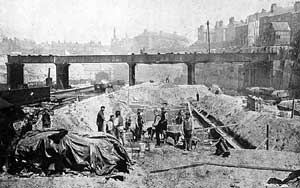
Navvies at work on the construction of Victoria Station, c.1896.
The main railway development during this period was the construction of the Great Central Railway (GCR) between 1895 and 1899. This ‘London extension’ to the Manchester, Sheffield & Lincolnshire Railway’s (MS&LR) network linked Annesley (near Mansfield) to the terminus of the Metropolitan Railway at Quainton Road in Buckinghamshire. The 92-mile route was the brainchild of Sir Edward Watkin, the dynamic chairman of the MS&LR whose grand ambition was to build an independent line between the industrial cities of Manchester and Sheffield south to London and through a Channel tunnel to Paris and the European markets.
This was a huge and expensive project involving massive construction work and land purchase on a large scale. For example, the building of Victoria Station in Nottingham led to the demolition of 1,300 buildings, the digging of 2,250 yards of tunnels and the excavation of 600,000 cubic yards of rock to make a vast cutting for the station buildings. Passenger services on the GCR began in March 1899.
The opening of Victoria Station put the architecturally plain Midland station dating from 1848 to shame and a new building, designed by the same architect, was built in Edwardian Baroque Revival style on Carrington Street in 1904. The new station had five through platforms and a bay and was able to cope with the 162 daily departures.
The Lancashire, Derbyshire & East Coast railway was designed to link the coalfields with a port at Warrington and docks to be built at Sutton on Sea on the Lincolnshire coast and the company completed part of this ambitious scheme by opening a main line between Lincoln and Chesterfield, through Tuxford, Ollerton and Warsop, in 1897. The scheme, however, ran out of money and the rest was never built.
At the close of 19th century, the GNR was spending a lot of money on building railways in challenging circumstances. A short but important connection running entirely on viaducts and bridges opened in 1899 from the Grantham line through inner Nottingham to Weekday Cross on the GC so GNR trains would be able to reach Victoria Station when it was completed. The extension of the Leen Valley line to Sutton in Ashfield and Shirebrook in 1897-1901 tapped a developing part of the coalfield but involved an enormous amount of rock excavation.
At the beginning of the 20th century the railways had virtually no competition from other forms of transport. However, the situation was soon about the change: Bartons began their Nottingham-Long Eaton bus service in 1908 and electric trams, which came to serve almost every big town, began to attract more and more customers away from the trains.
The First World War to Nationalisation
The First World War had a profound effect on railway companies: they were immediately placed under government regulation to control and co-ordinate vital traffic movements. Central control led to a degree of rationalisation and several marginal operations ceased during the war: e.g. local stations on the Nottingham Suburban Railway, and MR passenger facilities at Sutton in Ashfield, Kimberley and on the Ripley-Langley Mill line. Most were never reinstated.
However, the period also saw new railways open. Coal traffic from newly sunk mines around Mansfield inspired the privately promoted Mansfield Railway which ran between Kirkby-in-Ashfield and Clipstone Junction, was operated by the GCR and only completed during 1917.
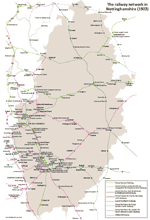
Map of the railway network in Nottinghamshire in 1922 (click on the image to view a larger version of the map).
The railways hardly had time to recover from state control during WWI and the introduction of the eight-hour working day before the Grouping of 1923 created its own administrative upheavals. The Railways Act of 1921 (“The Grouping Act”) was an attempt to control the financial losses being made by the 120 railway companies and maintain some of the benefits that derived from the government-controlled railway system during World War I. The act led to the creation of the ‘big four’ railway companies: Southern Railway (SR), Great Western Railway (GWR), London, Midland & Scottish Railway (LMS), and the London North Eastern Railway (LNER). The LNER took over the Great Northern Railway, the Great Central Railway and the LMS included the Midland Railway and the London and North Western Railway companies.
The Big Four faced increasing competition for goods traffic from lorries and for passengers from bus companies and Nottingham Corporation’s trolleybuses in the 1920s. The railway companies’ response was to rationalise their operations and there were severe cutbacks during the late 1920s and early 1930s. The LNER was at the forefront of the closure programme and the ex-GN Leen Valley line bore the brunt of the cuts and by September 1931 all the stations had closed. Passenger services were also withdrawn from the moribund Nottingham Suburban line. Other passenger services stopped during this period: the Mansfield to Southwell service ceased in 1929 and colliery villages on the LMS lines west of Mansfield also had their services withdrawn.
In 1925 the LNER and LMS collaborated on the construction of the Mid-Nottinghamshire Joint Line between Bestwood and Retford to transport coal from the new pits and Blidworth and Bilsthorpe. The first section, between Farnsfield and Ollerton, opened in 1931 and coal was taken to the LMS’s line between Mansfield and Rolleston Junction and from there to Nottingham.
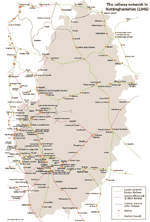
Map of the railway network in Nottinghamshire in 1946 (click on the image to view a larger version of the map).
At the outbreak of World War 2, the railways once again came under government control and at first services were drastically cut back, although most were restored by the end of the war. Nottingham endured 11 air raids during WW2, the worst being on the 8/9 May 1941 when the area around the Midland Station was bombed, the LMS carriage sheds and sidings at Eastcroft were flattened, the LNER’s London Road low level goods warehouse was damaged by fire and the former LNWR goods warehouse on Manvers Street was almost completely destroyed.
British Rail, 1948-1997
The Labour government came to power in July 1945 with a large majority and a mandate to nationalise the railways. The Transport Act of 1947 was passed despite considerable opposition and brought virtually all railways under the control of the British Transport Commission. On 1 January 1948 British Railways was born. All LMS lines in Nottinghamshire became part of the London Midland Region whilst Eastern Region took over the LNER routes. GCR lines were originally assigned to the Eastern Region but were transferred to the London Midland Region in 1958.
Dr Richard Beeching was appointed as Chairman of the British Railways Board in 1961 with a remit to find a way to returning the industry to profitability as soon as possible. His infamous 1963 report, The Reshaping of British Railways, used simple profit-or-loss criteria to recommend closure of over a third of the country’s railway stations and the withdrawal of passenger services from around 5,000 route miles. In Nottinghamshire this led to the closure of local stations and the ending of freight services on former Great Central lines in 1963, the withdrawal of the Nottingham Victoria to Derby Friargate service and the closure of the Nottingham Midland to Worksop service in 1964. Mansfield was to become the largest town in England without a railway service, a situation not addressed until 1994. The MR’s Leen Valley line was closed to passenger services in 1964 but mineral traffic continued to run along it.
Main lines were not exempt. The Great Central lost its expresses to London in 1960, local services between Nottingham and Sheffield ceased in 1963 and Victoria Station closed in September 1967. London express services were also withdrawn from the Nottingham-Melton Mowbray route in 1967.
However, the 1960s saw some developments resulting from the coal industry opening new collieries to the east of the established coalfield. New branch lines were built by BR to serve Cotgrave and Bevercotes pits and BR adopted the ‘merry-go-round’ system to transport coal from the collieries to power stations.
Mansfield had, with Gosport in Hampshire, enjoyed the dubious honour of being the largest towns in the country without direct access to a passenger rail service. A new station, the Mansfield and Alfreton Parkway on the Nottingham-Leeds route, was opened in 1973 but the station was eight miles from the town. The railway connection between Nottingham and Mansfield was restored in 1995 with the opening of the Robin Hood Line. The line was subsequently extended to Worksop in 1998. Interestingly, the line uses trackbeds and track alignments formerly belonging to the MR, GCR, GNR and the Mansfield & Pinxton railway!
The East Coast Mainline which runs through Newark and Retford was electrified in the late 1980s and the InterCity 225, the fastest locomotive-hauled domestic train in the United Kingdom, was introduced on the route in 1990.
Privatisation
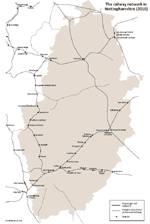
Map of the railway network in Nottinghamshire in 2010 (click on the image to view a larger version of the map).
The Major government pushed through the privatisation of British Rail in 1996 and rail services in Nottinghamshire are again run by private companies: East Midlands Trains, Midland Mainline, Central Trains, Northern Trains, National Express East Coast, and GNER have all run services in the county. The most recent development has been the opening in 2009 of the East Midlands Parkway station near Ratcliffe-on-Soar power station which is designed to serve commuters into Derby, Nottingham, Leicester and London St Pancras and also provide access to East Midlands Airport.
The impact of railways in Nottinghamshire
The impact of the railways was profound and utterly transformed many aspects of life in the country. As Christian Wolmer has observed,
“They made possible journeys that a generation before would have seemed completely implausible. They boosted all kinds of trade, stimulated economic development, brought in their wake a whole host of social and political changes, and played a vital part when the country went to war.”
Railways had a significant influence on the physical growth of towns. Most market towns served directly by a line became railheads for the surrounding villages and facilities developed accordingly. Towns on the main lines prospered most: Retford and Newark both grew rapidly after the GNR London to York line had been completed in 1852. The construction of the Central (later Victoria) station in Nottingham in the 1890s involved the demolition of hundreds of homes and businesses.
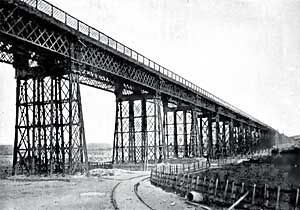
Bennerley Viaduct, c.1890.
They also had a dramatic impact on the landscape. This is particularly marked on the west side of Nottinghamshire. The Erewash valley was criss-crossed with railway embankments and viaducts; the imposing 1440-foot long Bennerley Viaduct still stands but the equally impressive ‘40 Bridges’ brick viaduct near Awsworth was regrettably flattened in 1973.
The close relationship between developments in the coal industry and the expansion of the railways is clear but other industries took advantage of the benefits of the growing railway network. For example, engineering firm of W. N. Nicholson in Newark was quick to use the railways to distribute its agricultural machinery and even moved its works from the Market Place to a purpose-built factory near to the Midland Railway line in 1858.
Railways were big employers and ‘railway settlements’ to house their workers were developed near the stations and yards. For example, in the 19th century Netherfield on the east side of Nottingham consisted only of a handful of fields but after the GNR established the Colwick locomotive works and sidings in 1875 it became a thriving village. The railway companies provided some housing in Netherfield (the GNR constructed two rows of terraced houses imaginatively titled “Locomotive Terrace” and “Traffic Terrace” and the LNWR later added “North Western Terrace”) but most staff lived in the nearby privately-built streets. Similarly, the hamlets of Thrumpton and South Retford to the south of Retford expanded dramatically after 1850 to accommodate railway workers serving the MS&LR and GNR locomotive sheds and stations. The 1841 Census records a mainly rural population here but by 1871 a small army of railway guards, engine drivers, engine cleaners, engine fitters, signalmen, porters, shunters, clerks, and railway inspectors inhabited the area.
Sources
- Anderson, P. H. The East Midlands (Forgotten Railways, 2). 2nd, rev., David St John Thomas (1985)
- Anderson, P. H. The East Midlands (Regional Railway Handbooks, 1). David St. John Thomas (1986)
- Leleux, Robin. A regional history of the railways of Great Britain. Volume IX. The East Midlands, David & Charles (1986)
- Vanns, M. A. Rail Centres: Nottingham. Addlestone, Surrey, Ian Allan, (1993)
- Waite, Peter Barrie. A history of the Great Northern Railway's Colwick Motive Power Depot and Marshalling Yard, incorporating the Nottingham Colwick Estates Light Railway and the London & North Western Railway's Netherfield & Colwick Engine Shed, Book Law Publications (2004)
- Wolmar, Christian. Fire & Steam. A new history of the railways in Britain, Atlantic Books (2007)
